Kiedy po raz pierwszy zaczęliśmy korzystać z Google AMP w 2016 roku, wydawało się, że jest to przyszłość mobilnej sieci. Jednak z biegiem lat pomogliśmy setkom właścicieli witryn internetowych odejść od AMP ze względu na jego ograniczenia i zmieniające się stanowisko Google w sprawie indeksowania mobilnego.
Podobnie jak wielu użytkowników WordPress, być może zastanawiasz się, czy nadszedł czas, aby wyłączyć AMP na Twojej witrynie. W związku z tym, że Google nie wymaga już AMP do uzyskania najwyższych pozycji w wyszukiwarce i wzrostu liczby rdzeni stron internetowych, nasi czytelnicy regularnie zadają nam pytania dotyczące usuwania AMP.
Przetestowaliśmy wiele metod prawidłowego wyłączania AMP w różnych konfiguracjach WordPress. Podzielimy się z Tobą najbardziej niezawodnymi metodami, które nie zaszkodzą Twojemu SEO ani wydajności mobilnej.
Niezależnie od tego, czy korzystasz z oficjalnej wtyczki AMP, czy z motywu z wbudowaną pomocą techniczną AMP, pokażemy Ci dokładnie, jak płynnie dokonać tego przejścia.
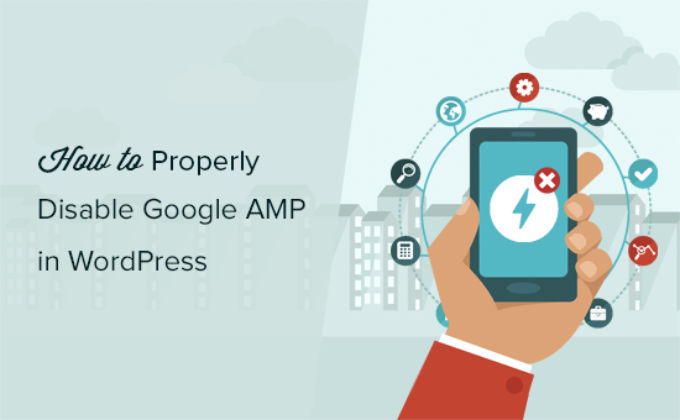
Dlaczego warto wyłączyć Google AMP w WordPress?
Przyspieszone strony mobilne (AMP) to inicjatywa typu open-source mająca na celu przyspieszenie działania sieci dla użytkowników mobilnych i poprawę komfortu korzystania z niej.
Czyni to poprzez serwowanie stron z minimalną ilością HTML i JavaScript. Pozwala to na hostowanie treści w pamięci podręcznej Google AMP. Google może następnie serwować tę wersję w pamięci podręcznej użytkownikom natychmiast po kliknięciu twojego odnośnika w wynikach wyszukiwania.
Jeśli jednak zdecydowałeś się skonfigurować Google AMP w WordPress, możesz mieć wrażenie, że dokonałeś złego wyboru.
Nie jesteś sam. Wielu blogerów, influencerów i publikacji internetowych przestało używać AMP na swoich witrynach internetowych WordPress.
Najpierw omówimy, dlaczego warto rozważyć wyłączenie AMP na twojej witrynie internetowej WordPress, a następnie przeprowadzimy cię przez ten proces.
Google Analytics 4 nie obsługuje AMP
Google Analytics 4 lub GA4 to najnowsza wersja Google Analytics, która śledzi Twoją witrynę internetową i aplikacje mobilne na tym samym koncie. Wprowadza ona wiele zmian, w tym nowe metody śledzenia, funkcje raportowania, metryki i raporty.
Wśród tych zmian jest to, że GA4 nie obsługuje obecnie oficjalnie AMP i nie jest potwierdzone, czy będzie działać w przyszłości. Jednym z powodów jest to, że śledzi on odwiedzających twoją witrynę internetową i aplikację w tej samej właściwości.
Google poinformowało jednak, że dostęp do starych danych w Universal Analytics będzie możliwy tylko do 1 lipca 2024 roku. Oznacza to, że nadal można uzyskać dostęp do raportów Universal Analytics, aby zobaczyć dane z przeszłości, ale nie będzie można ich jeszcze śledzić w najnowszej wersji.
Drastyczny spadek współczynnika konwersji
Google AMP nakłada wiele ograniczeń na HTML/JavaScript. Oznacza to, że w AMP brakuje wielu interaktywnych elementów Twojej witryny internetowej WordPress, takich jak formularze optin i wyskakujące okienka exit-intent.
W rezultacie właściciele witryn nie mogą zachęcać użytkowników do subskrypcji, wypełniania formularzy kontaktowych lub kupowania rzeczy.
Mniejsza liczba odsłon przez użytkowników mobilnych
AMP nie wyświetla paneli bocznych Twojej witryny ani innych funkcji odkrywania treści. Powoduje to znaczny spadek liczby odsłon przez użytkowników mobilnych.
W rzeczywistości niektórzy eksperci ds. doświadczeń użytkowników sugerują, że przycisk zamykania na górze faktycznie zachęca użytkowników do powrotu do wyszukiwarki Google po przeczytaniu twojego artykułu zamiast przeglądania twojej witryny internetowej.

Niższe zaangażowanie użytkowników
Wiele witryn internetowych rozwija się dzięki interakcjom użytkowników, takim jak widżety typu “kliknij, aby wysłać tweet“, oceny użytkowników, komentarze itp. Google AMP utrudnia właścicielom witryn internetowych utrzymywanie zaangażowania użytkowników i interakcji z ich treścią.
Czy należy wyłączyć Google AMP?
Odpowiedź na to pytanie zależy tak naprawdę od twojej witryny internetowej. Jeśli użytkownicy mobilni stanowią większość twojej publiczności, nadal możesz chcieć korzystać z AMP.
Z drugiej strony, jeśli wypróbowałeś Google AMP i miało to negatywny wpływ na ocenę konwersji, to prawdopodobnie powinieneś wyłączyć Google AMP na twojej witrynie internetowej.
Wbrew powszechnemu przekonaniu, Google nie karze witryn internetowych za nieużywanie AMP. Nadal możesz poprawić szybkość i wydajność swojej witryny internetowej na urządzeniach mobilnych, aby konkurować o mobilnych odbiorców wyszukiwania.
Mając to wszystko na uwadze, zobaczmy, jak można wyłączyć AMP na twojej witrynie internetowej WordPress.
Wyłączanie wtyczek Google AMP w WordPressie
Nie wszyscy używają tych samych wtyczek WordPress, aby dodać pomoc techniczną AMP do swoich witryn internetowych. Jednak podstawowe ustawienia pozostają takie same niezależnie od używanej wtyczki.
Pierwszą rzeczą, którą należy zrobić, jest wyłączanie zainstalowanej wtyczki AMP.
Wystarczy przejść na stronę Wtyczki ” Zainstalowane wtyczki z twojego kokpitu WordPress i kliknąć “Wyłącz” pod nazwą wtyczki AMP.
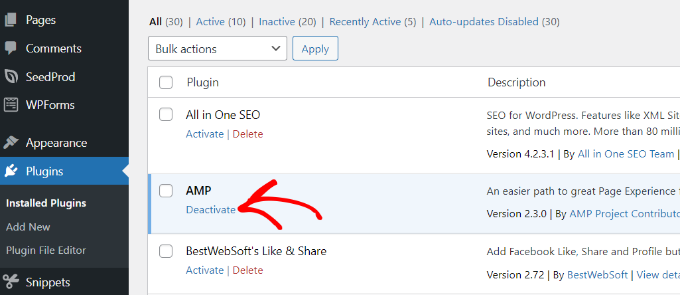
Samo wyłączanie wtyczki spowoduje wyłączenie pomocy technicznej AMP na twojej witrynie internetowej. Istnieje jednak jeszcze kilka kroków, które należy wykonać, aby upewnić się, że twoja witryna jest wolna od AMP.
Konfigurowanie przekierowań dla stron AMP
Wyłączenie wtyczki AMP powoduje usuwanie wersji AMP twoich artykułów z witryny internetowej. Jednak samo to nie wystarczy, zwłaszcza jeśli AMP jest włączone dłużej niż tydzień.
Istnieje duża szansa, że Google ma już zaindeksowane te strony i będzie je wyświetlać w wynikach wyszukiwania. Jeśli użytkownik kliknie na jedną z nich i usuniesz ją z twojej witryny, znajdzie stronę 404, ponieważ brakuje tej treści.
Aby poprawić ten problem, należy przekierować użytkowników odwiedzających strony AMP na zwykłe strony bez AMP.
Pokażemy Ci dwie różne metody ustawiania przekierowań dla Google AMP, najpierw za pomocą wtyczki, a następnie za pomocą kodu. Możesz wybrać tę, która jest dla Ciebie najwygodniejsza.
Metoda 1: Korzystanie z wtyczki przekierowującej
Najprostszym sposobem na skonfigurowanie przekierowania w WordPress jest użycie wtyczki All in One SEO (AIOSEO). Jest to najlepsza wtyczka SEO dla WordPressa, która oferuje potężny menedżer przekierowań.
Pamiętaj, że będziesz potrzebować licencji AIOSEO Pro, ponieważ zawiera ona menedżera przekierowań.
Najpierw należy zainstalować i włączyć wtyczkę All in One SEO (AIOSEO). Aby uzyskać więcej informacji, zobacz nasz przewodnik krok po kroku, jak zainstalować wtyczkę WordPress.
Po włączaniu można przejść do All in One SEO ” Redirects z kokpitu WordPress i kliknąć przycisk “Activate Redirects”.
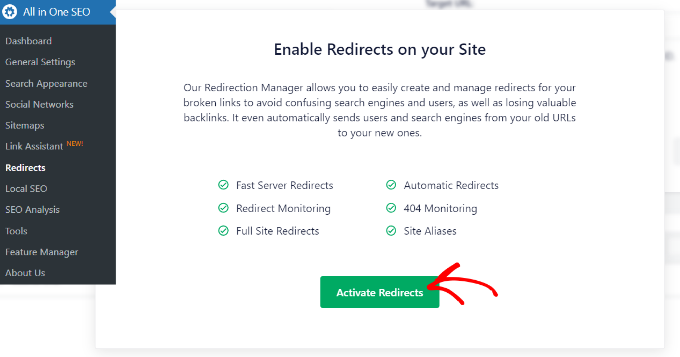
Pomoże to zainstalować dodatek AIOSEO Redirection Manager, który obsługuje tę funkcję. Po włączaniu, zostaniesz przeniesiony do karty “Przekierowania”. Tutaj możesz wpisz źródłowy i docelowy adres URL, aby skonfigurować przekierowanie.
Najpierw należy kliknąć ikonkę koła zębatego w polu Source URL, a następnie włączyć pole wyboru “Regex”.
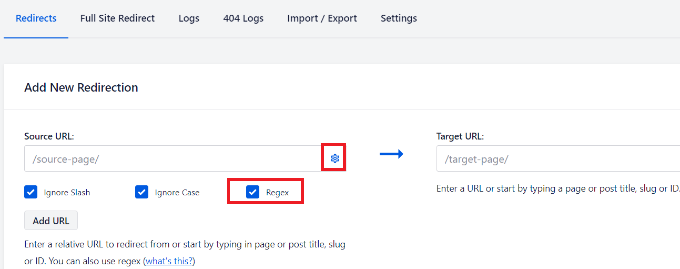
Następnie możesz dodać następujący kod w polu Source URL:
1 | ^/(.*)\/amp |
W polu Docelowy adres URL należy dodać adres URL twojej witryny internetowej w następującym formacie:
1 | https://example.com/$1 |
Nie zapomnij zastąpić “example.com” twoją własną nazwą domeny.
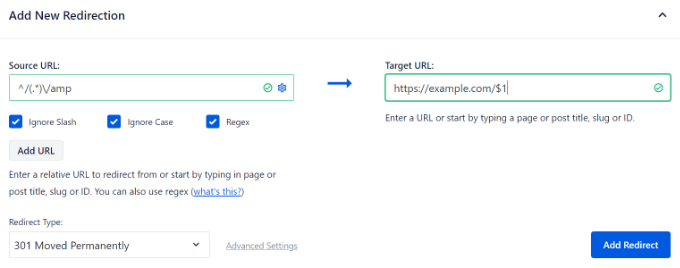
Następnie możesz zachować “Rodzaj przekierowania” jako 301 Przeniesione trwale. W ten sposób twoi użytkownicy będą trwale przekierowywani na strony bez AMP.
Na koniec kliknij przycisk “Dodaj przekierowanie”, aby zapisać twoje zmiany.
Możesz teraz przejść na adres URL dawnej strony AMP w twojej witrynie internetowej, aby sprawdzić, czy przekierowanie działa poprawnie.
AIOSEO pomaga również śledzić niedziałające odnośniki w Twojej witrynie internetowej. Możesz szybko zidentyfikować strony AMP prowadzące do błędów 404 i przekierować je. Aby uzyskać więcej informacji, zapoznaj się z naszym przewodnikiem na temat śledzenia stron 404 i przekierowywania ich w WordPress.
Metoda 2: Ręczne ustawienie przekierowań w .htaccess
Jeśli nie chcesz używać wtyczki do ustawiania przekierowań, możesz skonfigurować przekierowanie za pomocą pliku .htaccess na twoim koncie hostingowym WordPress.
Najpierw musisz połączyć się z twoją witryną internetową za pomocą klienta FTP lub Menedżera plików w cPanel. Aby uzyskać więcej informacji, zapoznaj się z naszym przewodnikiem na temat korzystania z FTP do przesyłania plików w WordPress.
Po nawiązaniu połączenia należy zlokalizować plik .htaccess w katalogu głównym twojej witryny internetowej.

Następnie możesz edytować plik w twoim katalogu głównym.
Następnie wystarczy dodać następujący kod na dole twojego pliku .htaccess:
1 2 3 4 | // Redirect AMP to non-AMPRewriteEngine OnRewriteCond %{REQUEST_URI} (.+)/amp(.*)$RewriteRule ^ %1/ [R=301,L] |
Nie zapomnij zapisać zmian i przesłać pliku z powrotem na twój serwer.
Możesz teraz odwiedzić adres URL poprzedniej wersji AMP dowolnego wpisu na twojej witrynie internetowej, aby upewnić się, że przekierowanie działa zgodnie z zamierzeniami.
Mamy nadzieję, że ten artykuł pomógł Ci prawidłowo wyłączyć Google AMP w WordPress. Możesz również zapoznać się z naszym przewodnikiem SEO WordPress krok po kroku dla początkujących i najlepszymi wskazówkami, jak przyspieszyć WordPress.
If you liked this article, then please subscribe to our YouTube Channel for WordPress video tutorials. You can also find us on Twitter and Facebook.





Sarah
Hi,
Tried adding :
// Redirect AMP to non-AMP
RewriteEngine Aan
RewriteCond %{REQUEST_URI} (.+)/amp(.*)$
RewriteRule ^ %1/ [R=301,L]
But still lots of 404’s looking for AMP?
WPBeginner Support
We would recommend checking with your hosting provider as some have settings that need to be applied for redirects to work.
Admin
Ravi Bandakkanavar
Thanks for the redirection trick. It worked like a rocket
WPBeginner Support
Glad our guide could help!
Admin
Vyom Manikya
After following all the steps, now I’m getting this error “Discovered – Currently not Indexed” for my non-amp pages.
Loren
I’ve tried applying this to a site I’m working on without any luck. I’ve cleared cache and tried a handful of other things, but the redirects do not seem to be catching. Does this work for sites that google is wrapping the url in themselves?
Scott Hunt
I installed the Redirection Plugin and followed the process. Amp was only Active on our mobile version and only showed if our website was searched, for example, Delta, and then clicked on the link. If you entered the URL in the address bar it would show our website correctly. I am at a loss!
I know it was amp because Amp is the in URL when the website is not displayed correctly. Any advice would be sincerely appreciated.
WPBeginner Support
You would want to ensure you clear any caching you have on your site as that could be showing the cached version of the page on your site instead of the updated version.
Admin
James
Hey WPbeginner, Great article and helped me so much with my website .
Thanks
WPBeginner Support
Glad our guide was helpful
Admin
GILL COTTER
I did it and it works thanks.. I was in a panic. Just one thing – a little sad looking emoji guy pops up and says ‘404 that’s an error’ just before the user is directed to the correct page. It pops up for a minute then goes away. How can I get rid of him?
WPBeginner Support
You may either need to clear your browser cache or check with your hosting provider to ensure there isn’t something causing issues with your redirects.
Admin
Hicham
It works, Thanks so much ☺
WPBeginner Support
Glad our guide was helpful
Admin
Akshay Malhotra
Thank you so much for this post. As always WP beginner rocks!
WPBeginner Support
Glad you found our content helpful
Admin
sai ram
I have removed AMP from my website but when disabled my AMP i will recieved new issue in Google Search Console as a “Referenced AMP url is not an AMP”.
Please tell me sir how can it solved.
WPBeginner Support
You would want to set up redirection following step 2 for fixing that issue.
Admin
Mustafa
That’s great info and help guys. Thanks a lot. Here’s my question:
What is the right direction code or way for redirect my old website’s amp pages to my new domain’s non-amp pages?
WPBeginner Support
You would want to follow step 2 in the article and have the source URL be the old domain before the / in our recommendation.
Admin
Daniel
Can I delete the Redirect plugin when all the amp pages are deindexed from Google?
WPBeginner Support
We would recommend keeping the plugin active while using the redirect if you use the plugin method.
Admin
Faiz Khan
Today I desabled AMP plugin. When I checked my website with AMP URL it showing error.
WPBeginner Support
That issue is solved with the redirects which we show in this article
Admin
Stephen Walker
Hit a little snag. I have added the code you suggest to my .htaccess file. I now get an internal error 500 from the server if I am trying to access an amp post. Normal pages display correctly.
WPBeginner Support
For the 500 error, we would recommend first going through our guide below for possible solutions:
https://www.wpbeginner.com/wp-tutorials/how-to-fix-the-internal-server-error-in-wordpress/
Admin
Alvine
Thanks for the wonderful article. I wonder how one can remove just a single page from amp. Your method only explains removing all amp pages of a website but I want to remove just one page. How can I remove it please help.
WPBeginner Support
You would want to check with the plugin’s support for if that is currently an option. Normally, you should see an option on the page/post itself to not use AMP.
Admin
Laura
This is super easy to follow, so I’m so grateful to have found this post – but my AMP pages are still showing on Google, even after doing the redirection using the Redirection plugin. I’m not sure what to do, I saw in the comments something about caching, but I’m not sure how to do this?
WPBeginner Support
For Google’s cache, you would need to have Google recrawl your site with its URL checker or wait for Google to notice the update and change your links.
Admin
Adeel Qadir
Thanks for such a nice article and your way of explaining was very simple. With this helpful article, I have easily redirected my website and remove AMP successfully.
Lots of thanks
WPBeginner Support
You’re welcome, glad our guide was helpful
Admin
Parkashjit Singh
Hi Sir, i following all the steps but, i saw all the amp link on google which are ranked now how i can removed that amp ranked links on google. As well when i search on google about my site then i saw amp logo after my site tittle even now I’m not using apm. Now how i removed that icon.
WPBeginner Support
You would need to have Google recrawl your site to start removing the content from Google’s search results.
Admin
Parkashjit Singh
How, is there any tutorial or bog. Please send me
WPBeginner Support
You can find our article on how to do this below:
https://www.wpbeginner.com/wp-tutorials/how-to-ask-google-to-recrawl-urls-of-your-wordpress-site/
Raj Deep
My site uses ssl and is on https. Should I use https or http in the redirection ?
WPBeginner Support
Use HTTPS
Admin
Robin
Hey I have page which have /?amp AMP format. So what change I have to do for proper redirection,
As the code given above /(.*)\/amp is only redirection pages with /amp.
Please tell me what change required for this ? thing.
WPBeginner Support
You could create an additional redirect where you add * before amp if you customized your amp URLs to show like that.
Admin
Bob Morris
Thanks. I found this article after one too many posts with 17 indecipherable AMP errors
WPBeginner Support
Glad our guide could be helpful
Admin
Farblos Kay
This is the best website to learn and fix anything WordPress. You guys are geniuses!
WPBeginner Support
Thank you, glad you find our content helpful
Admin
Subodh Gupta
I have disabled AMP on my site using the mentioned codes. But the post/page previews are showing in AMP mode. What to do? Using TagDiv NewsPaper theme.
WPBeginner Support
You would want to ensure you’ve cleared all of your caching for the most common reason for that.
Admin
Adnan
Yours AMP pages are in Google cache, so when Google Bot re-index and check no rel=”amphtml” tag they index non-AMP page.
Julia
Hi, this article sounds very useful, thanks for sharing!
Before I will deactivate/uninstall AMP plugin as well, I have to ask a question.
I have, by mistake, redirected few of amp links (with amp plugin already installed) to my normal url link:
example.com/amp to example.com
The reason why I did that redirect with redirection plugin, is that I had no knowledge of what amp is, and so I thought it’s an error, when I was migrating my site.
Now my question is, should I rather disable all my redirects with amp and then disable/uninstall the AMP plugin and then do the bulk redirect ?
Thank you for your help!
WPBeginner Support
To be safe you may want to create an export of your current redirects, remove them, then do the method in this article to prevent the possibility of multiple redirects
Admin
Pratik Bhatt
Hi,
Can you tell me, when we can remove the redirection plugin. Does google remove the amp pages automatically after some time?
WPBeginner Support
Once the amp pages are no longer being indexed you can remove the redirection. It takes time and Google recrawling your site for the links to be removed.
Admin
Pratik Bhatt
Thanks for the quicky reply.
One more question, I’ve to ask, If I don’t do the redirection, then still google remove the amp pages after some time?
Thanks.
WPBeginner Support
Eventually yes
sam
Hi
I followed the steps above. However, when searching on my mobile device the amp pages are still popping up (It’s only been a few hours so this may be why). When I search on desktop device and type in domain.com/amp the redirect works perfectly. Do you know why this is happening?
WPBeginner Support
You would need to clear any caching as the most common reason it would still be showing up.
Admin
Kuldeep Singh
Worked like a charm.
Thanks!
WPBeginner Support
Glad our guide was helpful
Admin
Jason
Great Guide! Worked like a charm.
WPBeginner Support
Thank you, glad our guide was helpful
Admin
ahs shaikh
thank you very much for this blog post…
WPBeginner Support
You’re welcome
Admin
Rahul sarawagi
Hey,
I tried this way and now my website is not loading, it is giving an error message that
” redirected you too many times ”
Please help me out in getting it back.
WPBeginner Support
For the too many redirects error, you would want to take a look at our guide here: https://www.wpbeginner.com/wp-tutorials/how-to-fix-error-too-many-redirects-issue-in-wordpress/
Admin
Dietrich
I have done method 1 and cleared/deleted cache and it still shows the AMP version? Any tips how to fix?
WPBeginner Support
You would want to check that your host does not have caching enabled and your redirects do no have any typos
Admin
Rohit verma
i have done the first method but it still shows amp version what to do?
WPBeginner Support
You would want to clear any caching as the most likely cause
Admin
Subham
Hi,
You guys are doing great.
After creating AMP i have seen down in my traffic.
So i decided to remove that and i did.
I got many errors. So, i had to install amp again.
Now finally this article helped me a lot to completely remove amp.
Thank you very much WPbeginner.
You are a lifesaver!
WPBeginner Support
Glad our guide could be helpful
Admin
Catherine Thomas
THANK YOU!!!! Method #1 worked perfectly!!!
WPBeginner Support
Glad our recommendations could help
Admin
Akash Gogoi
Can I disable redirection plugin after AMP completely gone from Google search result? Please help.
WPBeginner Support
If you would like you can. Be warned that would remove the redirects so if the links start appearing as broken links in your search console you may need to readd the redirects.
Admin
Enes
Hey. Thank you very much for the info but i had a question. It does not work with me method 1. it suppose to be non amp as soon as i do redirect right ?
my website is https so i made it as https that what it should be ? Thanks in advance
WPBeginner Support
If you are using https then you would want the second field as https, as long as you don’t have caching then it should automatically update. If not, you would want to reach out to the plugin’s support for them to take a look.
Admin
Suanlian Tangpua
When should I remove the redirection?
WPBeginner Support
As it would depend on if Google still links to your AMP pages, we don’t have a set time to remove it we would recommend at the moment.
Admin
Hiral
Hi, thanks for helping. I used method 1. All the blog posts are being displayed in proper format but home page, about, contact such pages are still being displayed in AMP. How to fix it?
WPBeginner Support
You may want to check with the author of the redirection plugin to ensure there isn’t a hiccup with the created redirect.
Admin
Elsaid
Thanks a lot
Now I disable and delete AMP Plugin. and redirect lINKS by first method.
but I have a question , If I want reinstall AMP plugin again
what I should do about redirections????
WPBeginner Support
You would need to remove the redirections.
Admin
Kumarpal Shah
I’ve used Method 1 – Using Redirection Plugin. Now, my question is after adding the redirection is it necessary to keep plugin installed & activated?
OR I can remove the plugin after adding the redirection?
WPBeginner Support
Using the plugin, you would need to keep the plugin active for the redirects to continue.
Admin
Mario
It worked for me wpbeginner thanks a lot
Amp is not advisable use
WPBeginner Support
Glad our article could help
Admin
foodstyling
Hi,
I used the redirection method and the AMP pages are redirected to fine, but the address remain as /?amp.
Should I worry?
WPBeginner Support
If the redirection is working correctly, then you do not need to worry about the urls.
Admin
Mark Llego
I would like to know how can I 301 redirect if my amp url is structured like this
site.com/amp/your-article/
I am using better amp.
Thank you.
WPBeginner Support
Hi Mark,
The htaccess method in this post should handle that redirect for you
Admin
Joanna
Thank you so much! I was struggling with accidentally adding AMP pages and then removing them to losing a lot of traffic. Then, I felt defeated, so I reinstalled AMP. Method 1 with the Redirection plug-in was so easy I wish I had seen this sooner. THANKS!!
WPBeginner Support
Glad our article could help
Admin
Rajesh Ranjan
hii, i followed each and every step but its not working on my WordPress website.
WPBeginner Support
If you removed AMP completely and clearing your cache did not remove the AMP versions you may want to check with your hosting provider to ensure they don’t have caching or similar that would be affecting the AMP pages.
Admin
Margaret
I’m using the Yoast plugin for redirects – what do I input and where to redirect my amp urls to my non-amp ones?
Manh Nguyen
I do as instructed, how long does my site return to normal ?
Thanks!
katie larking
Hi I disabled the AMP plugin and set up a redirect as per the article. The redirect works, but the AMP pages are still in google index and working. How long until google replaces them with my non amp pages. Please let me know how long it takes organically vs anything I can do to speed this up that is proven to work. Thankyou!
Aaron Hunter
This helped so much thank you! I’ve asked WP support, and they had nothing to offer me for a solution. The new version of WordPress.com doesn’t let you deactivate AMP so I used the Redirection plugin. Thank you again!!!
Keith Whitworth
You are an absolute lifesaver! After implementing AMP, my user engagement dropped significantly, my site links in Google totally disappeared, my ranking (for my niche) was at the bottom of the barrel.
AMP is not really designed for podcasts AT ALL.
Once I decided it wasn’t going to work out, I deleted the plugin only to generate thousands of 404 errors related to AMP. I found myself creating unnecessary laborious work creating redirects every day as they popped up.
Finally, I got frustrated and performed a search and replace in my database to remove amp/ which was a massive mistake. Suddenly my site was no longer available. I deleted the plugin and everything was restored but what to do about all the 404 errors related to AMP?
I ran across your website through a Google search and presto. In one fell swoop, all my headaches disappeared. My sitelinks have been restored and yesterday I received an email from Google stating that mobile-first indexing was enabled on my site.
I cannot thank you enough!
WPBeginner Support
Hi Keith,
We are glad you found the article helpful You may want to join us on Twitter for more WordPress tips and tutorials. Next time you come across an issue, don’t forget to search WPBeginner first for a solution
You may want to join us on Twitter for more WordPress tips and tutorials. Next time you come across an issue, don’t forget to search WPBeginner first for a solution 
Admin